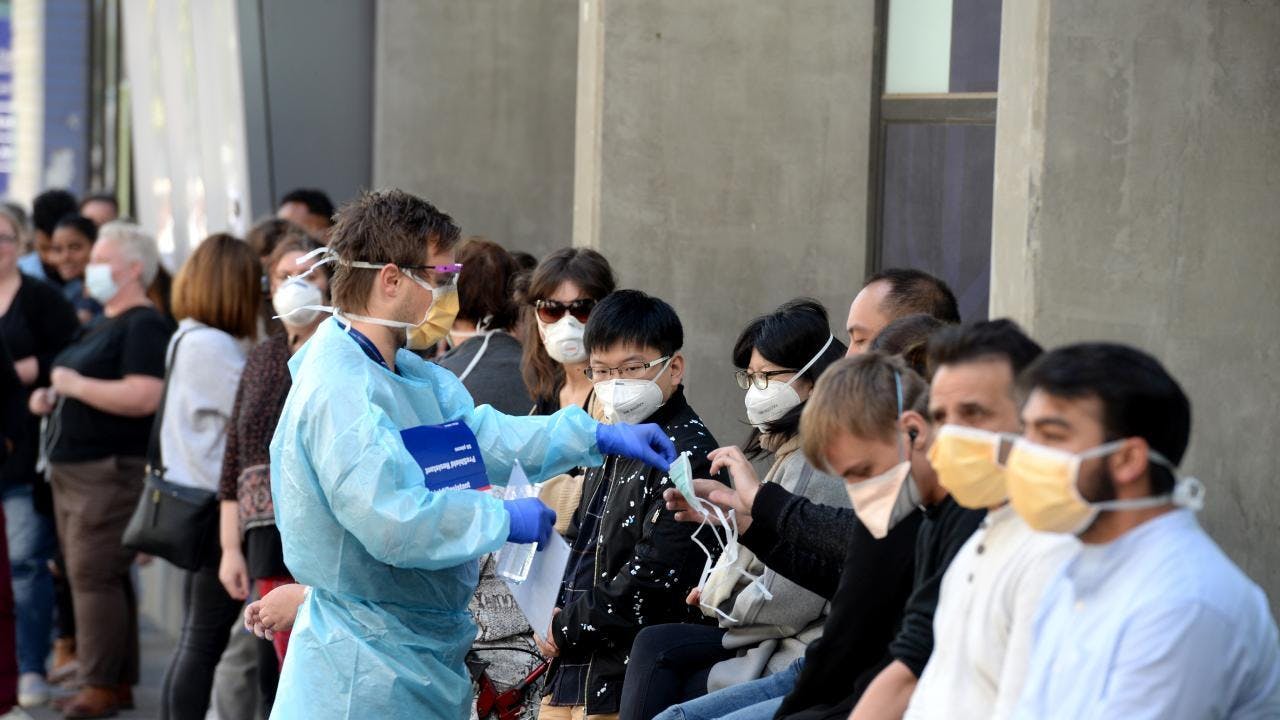I'm a public hospital doctor. We're not prepared

“Thank you for coming to work.” These words started the first, but certainly not the last, all-in team meeting to discuss measures being put in place to mitigate the biggest challenge to the Australian health care system in living memory.
The faces around me were pale, grim and determined. We have all been watching the crisis unfolding overseas with increasing alarm. And nobody could have missed the line of patients, wearing an assortment of masks, stretching for a block outside the entrance to the emergency department. As doctors in a public hospital we were all too familiar with the state of the current Australian health care system. We know what is coming for us and we know we are not prepared, not even close.
According to the most recent statistics from the Australian Institute of Health and Welfare, we have 62,000 beds in our public system. Only 1,485 of these are intensive care unit (ICU) beds. If you take into account private hospitals, the numbers go up fractionally: 95,100 beds and 2,023 ICU beds.
Because we are in the early stages of the epidemic in Australia, and the government’s emergency response has thus far been highly changeable, the exact trajectory of the virus in Australia is unknown. Epidemiologists estimate the likely infection rate will be 20-70 percent of the total population. Even using the most conservative estimate, that would mean as many as 252,000 concurrent ICU admissions. With full access to intensive care facilities, the death rate from the COVID-19 virus is currently around 1 percent. However, as we have seen in the countries worst affected, the death rate in an overwhelmed system without access to intensive care balloons out to 3 percent or more.
As harrowing as the figures are, it is important to note that they presume we will be able to function at full capacity. There will be a significant loss to the workforce from staff members in quarantine, those who are carers to vulnerable populations and who are taking leave to minimise secondary transmission, and those who are unable to work following the potential closure of schools. With junior doctors already routinely working upwards of 60 hours a week, even with the cancellation of leave and an increase in overtime, this loss will realistically mean a decrease in already inadequate functional hospital capacity.
We only need to look overseas to discover how devastating the consequences of this shortfall could be. Patients with COVID-19 will compete with those who need intensive care following car accidents, heart attacks and haemorrhages during child birth. In Italy, this reality has required instituting the most brutal and seemingly utilitarian approach. If you are over 65, you don’t get a bed. If you have ever had cancer, regardless of whether you are in remission, you don’t get a bed. If you have had an organ transplant, regardless of age, you don’t get a bed.
The risk to personal safety for health staff should not be understated. In China, the epicentre of the pandemic so far, health workers as young as 29 have been killed by the virus. This is because of the compounding factors of being exposed to more viral particles due to repeated and prolonged exposure, a shortage of personal protective equipment and, finally, the compromised immune system that results from a lack of sleep, adequate nutrition and the stress of overwork.
When you consider the broad age range and health conditions of medical staff, and that one of the contingency plans is to reintroduce retired nurses and doctors to bolster a flagging workforce, it is no exaggeration to say that we are being asked to put our lives on the line.
It is particularly jarring to be expected to accept the pittance being offered to us by the Morrison government, both in terms of resources and leadership. There is a nationwide shortage in both virus testing kits and masks that can prevent transmission. This has resulted in health guidelines being based on the availability of resources rather than scientific evidence. Masks are such a precious commodity in my hospital that they are being stored in the same locked cupboard as the morphine.
Despite confirmation that we have reached the community transmission phase of the pandemic in Australia, only people who travelled internationally in the 14 days before getting sick or who had close contact with a confirmed case of COVID-19 qualify for testing. Meanwhile, our universities, schools and many large businesses have continued to operate, vastly increasing the likelihood of an exponential rate of community transmission.
Consistent and clear information has been coming from both the World Health Organisation and our overseas medical colleagues advising against this sluggish response. But without a national centre for disease control and with a government more focused on the economy than public safety, our underfunded and atomised public health system has been unable to respond. Doctors are receiving guidelines and recommendations from upwards of three sources simultaneously. And with significant differences in policy between states and between hospitals, the medical response has been confused and uncoordinated.
Decades of attacks on our health system have taken a toll; it has taken a pandemic to lay bare just how ill-prepared our system is. While our politicians continue to harp on about protecting businesses, secure in the knowledge that resource shortages will not affect them, the rest of us will be left to fend for ourselves. If we are to survive first the health crisis and then the economic consequences that will surely follow, we will have to organise collectively and hand the bill to the politicians who have spent decades laying the groundwork for the carnage that at this point seems inevitable.